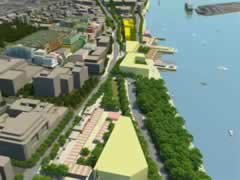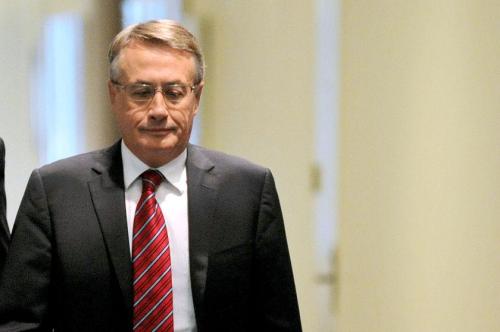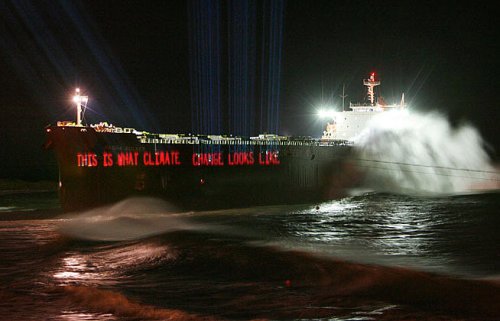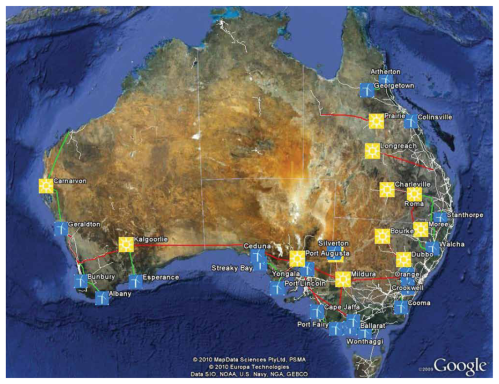Socialist Alliance Newcastle Branch
[Image- Dan Cox, ABC news]
1. We can have connectivity without cutting the line
The community campaign group Save Our Rail has been saying since 2008 that there should be level pedestrian crossings built over the line to achieve better connectivity between the city and the harbour (view the relevant document here). For around $25million we could have seven new at-grade crossings.
Of course, were these crossings built- even just a few of them – this would take away the main justification for cutting the line, because the rail would no longer act as a barrier. Cutting the line will cost hundreds of millions of dollars; level crossings are cheap to deploy. However, grubby politicians fear the threat of a good example.
Labor and Liberal politicians alike have claimed that (even though there is not actually any legislation preventing it) the ‘general’ railcorp policy is that for safety reasons they don’t like new level pedestrian crossings over rail lines. This general principle is portrayed by the pollies as being iron clad, immutable.
The Socialist Alliance says this is a complete cop out. The NSW government could not care one iota about public safety when it comes to approving new coal and coal seam gas projects that fuel dangerous climate change and trash our drinking water supplies and agricultural land. They weren’t too worried about public safety when it came to approving uranium exploration in NSW, despite having no mandate for this.
Yet they bung on the concern with regard to the simple (but politically inconvenient) solution that level pedestrian crossings present.
If achieving connectivity in Newcastle is so important that it comes down to a choice between either removing a vital piece of public transport infrastructure, or going against a ‘broad brushstokes’ policy of railcorp, the choice is clear.
The NSW department of planning can and should put its foot down and use its powers to ensure that at the very least, a trial of new level pedestrian crossings over the rail line occurs in Newcastle before throwing vast sums of money at cutting it.
2. There is no solution proposed for rail users affected by the cut
Neither the former NSW ALP government’s plan to cut the line – nor the Liberals’ current proposal – make any attempt whatsoever to explain how passengers will be shifted from rail to buses at a new Wickham terminus.
There is no room at the Wickham terminus for buses to meet passengers; they will have to board elsewhere. What this means is that (especially during the crucial morning and afternoon peaks), shifting from rail to bus for the last leg of a journey into the city will be a nightmare.
From a transport planning perspective this question is crucial- you don’t make people change from rail to another mode of transport unless it is absolutely necessary because doing so erodes the key advantage of rail – which is that it is fast and direct.
Changing to buses will also be especially problematic for wheelchair users, parents with prams, music strudents with bulky instruments, surfers (especially young people from up in the Hunter Valley) who use the service to get to Newcastle beach, blind and vision impaired people, and users who are older and less mobile.
The lengthy wait times that will result from the O’Farrell government’s half baked plan to chaotically just dump rail users at Wickham will see many people stop using the train – a point verified by independent transport planners.
3. The rail cutting plan is Newcastle centric and does not look at how boosting patronage on trains from feeder areas like Sydney, the Central Coast, Lake Macquarie, Maitland and the Hunter Valley can help revitalise Newcastle.
None of the talk of urban renewal in Newcastle is coming from a perspective of transit oriented development. Elsewhere in the world having rail near residental and commercial developments is correctly seen as a positive yet here in Newcastle the rail is demonised by vested interests.
Many small business owners in the Newcastle CBD are opposed to cutting the line because they know it brings in customers.
A serious strategy for urban renewal in Newcastle should look at getting more people from surrounding areas hopping onto the train and coming into the city. Save Our Rail have pointed out that the single most effective project in this regard would be the creation of a new transport hub at Glendale, linking the epicentre of the Hunter regions most populous area, Lake Macquarie, with picturesque Newcastle.
The creation a new station near Maitland at Aberglasslyn, improved access at Metford, and reopening stations at Oakhampton and Farley/Rutherford could better link Newcastle to these growing population centres via the Hunter line as well.
Due to decades of neglect and poor planning the rail service in the Hunter region is not utilised nearly as much as it could (and should) be.
Making the service more accessible and marketing it more effectively is the answer to this, not cutting its head off.
4. The plan dictates what Newcastle City Council should be spending its money on
The urban renewal strategy document released by the NSW government carries a great number of pretty pictures of repaved malls, fountains and water features, trees planted at various city locations, boulevardes, jersey kerbs on Hunter st to better accommodate alfresco dining, cycleways and more.
Many of these are good ideas, and it should be noted that just about all of them could be constructed without removing the rail line.
However all of these projects – $58.15million worth – are slated to be constructed using Section 94A developer contributions collected by Newcastle City Council.
Since when was it the NSW governments job to give local councils a $58million list of projects they are supposed to carry out? The most beneficial use of section 94A contributions – within the entire local government area, not just a small part of it – is something that is decided upon by democratically elected councils, not state governments.
The urban renewal strategy in fact goes further than this, re-tweaking an existing S94 budget from Newcastle city council and removing around $16million worth of items to make way for more of the beautification projects the authors of the report want to see delivered. Notably, this $16million of cuts includes the removal of $1.6million slated for a child care centre.
The report also calls for a massive expansion of parking restrictions and parking meters extending out from the CBD and into outlying suburbs.
Newcastle City council is in charge of its own affairs and it is not the place of the NSW government to instruct local governments what they should and should not be spending their budgets on. If the NSW government wants to drive urban renewal in Newcastle they need to make that investment themselves, not try and shift the cost onto the City Council.
5. Cutting the line will cause traffic chaos
It is important to think about the traffic implications of cutting the line at Wickham, which are considerable. The 2010 AECOM report into truncation at Wickham noted that it would be necessary to close the Railway street crossing (near the Lass O’Gowrie) and the Beaumont st. crossing, due to changed rail movements and stabling provisions.
[Image- AECOM truncation report, 2010]
Interestingly, the 2012 urban renewal strategy calls instead for an ‘improved crossing’ at Railway st despite the fact that having a terminus at Wickham will almost certainly dictate the closure of the crossing in question. It is as if the authors did not even read the most recent and comprehensive report into cutting the line at Wickham…
In September 2012 the Hunter Business Chamber released their woefully ill concieved 19 page document ‘Newcastle Central – a real solution, right now’.
Page 12 has the faux pas of the century, with a crude diagram depicting buses coming out of Beauford st (near the boxing gym adjacent to the current Wickham station), driving across Stewart avenue, picking up passengers from the new terminus, and then cutting back across Stewart avenue to head back into the city.
[Image- Hunter Business Chamber “Newcastle Central”, 2012]
Anyone who has been near this area in the morning or afternoon peaks knows it is quite congested at these times. The rail often gets blamed for this congestion when in reality it is the intersection of major east-west and north-south flows of vehicular traffic that is the cause.
Trying to send throngs of buses each way across Stewart avenue to pick up and drop off passengers coming and going from the train station is a recipe for making traffic problems in the area a whole lot worse.
The document also claims that expensive land acquisitions around the Store site detailed in the 2010 AECOM truncation report could be avoided by simply just building a three platform terminus instead of a four platform station such as the one already in existence at Newcastle.
The removal of a fourth platform has major implications for rail movements into and out of the station; for instance it would be impossible to have two trains arriving and two others leaving (such as a movement each way on each of the two distinct lines that come into the city) within a short space of time.
No explanation is given as to how these carriage juggling feats are to work nor how the Stewart avenue bus movement sleight of hand may be executed. We are just given the vague assurance that the plan was drawn up ‘in consultation with local engineers’.
This Business Chamber document is a perfect illustration of the completely gung ho, ‘she’ll be right mate’ attitude towards major transport and traffic planning questions that the lead proponents of cutting the line possess.
The NSW government have stated they are definitely going to cut the line. However like many other aspects of the urban renewal strategy report, so far there has been no modelling of the traffic impacts of a new Wickham terminus, of the bus and pedestrian flows from it, of the level crossings closed due to it, and no costing of measures that may be necessary to try and deal with such traffic flow on effects.
6. The city campus and other potential new development needs a direct rail connection
The University of Newcastle is building a new city campus near Civic station which is projected to have 8000 students and 1000 staff. The NSW government is proposing that a direct rail connection to the city campus be removed.
This is absolutely ridiculous. Enough said.
7. The economics don’t stack up
Putting aside the fact that it is a disastrous idea for a moment, it should also be noted that the $110million the NSW government has pledged so far towards cutting the line and building a new terminus, and the $10million it has pledged towards urban renewal projects, is nowhere near enough to make these thing happen.
A 2010 report into cutting the line at Wickham by consultants AECOM projected that the new terminus would cost between $375million and $505million. This is before additional buses (including drivers, cleaning etc) and associated infrastructure (like a bus terminal adjacent to the new station) are taken into account.
Potential road bypasses to cope with altered and stifled traffic flows would cost more again, and then there is the $58million in urban renewal projects outlined in the Governments reports on top of it all.
Supposedly the $120million pledged so far by the NSW Government will be used to leverage some even larger amount of money from the Federal Government; the theory being that once this money is spent cutting the line the private sector will then go on a construction frenzy.
Once all the developers new buildings are finished, deferred section 94A developer levies from them will pay for a rollout of the renewal initatives that the government reports are packed with pretty pictures of. Only once $1.94billion of new buildings are rolled out would the full suite of proposed renewal measures be built .
The fact that these urban renewal projects are to be paid for only after new development is built suggests that it is the cutting of the line and not the renewal projects that is supposedly going to attract this quite epic raft of private investment.
Yet new buildings in Newcastle already have low occupancy rates. Lots of offices and apartments, indeed entire buildings, lie empty. The cargo cult approach of ‘lets cut the rail line and watch heaps of people and developer dollars magically flow in’ is highly problematic. If new development is slow we will have a CBD with no rail but also without any of the pretty beautification projects depicted in the reports.
Does the approach add up? Does it in any way represent good value?
If the NSW government aborted its plan to cut the line it could fund the construction of new at grade pedestrian crossings, and fund an expanded version of Renew Newcastle. Renew Newcastle has been ensuring shopfronts and offices in the city get used rather than sitting empty.
Indeed, Renew Newcastle has produced a number of successful small businesses who have moved beyond this supported breeding ground and taken up proper commercial leases. Arguably it is this type of initiative, rather than whacking up more new buildings, that is key to revitalising the city – which by the way ain’t such a shabby old town, it’s a pretty sweet place.
There has been no cost benefit analysis of this latest plan to cut the line.
If the government wants to invest in urban renewal in Newcastle there are far better ways to do this than throwing vast piles of public money at cutting the rail line at Wickham and then hoping that as a result nearly two billion dollars of private investment will just magically flow in.
8. The ‘green corridor’ ruse is bollocks – developers want to build on the line
Barry O’Farrell lied about a Liberal government not taking the axe to public sector workers in NSW if elected; he lied about protecting water catchments in NSW from coal seam gas extraction and longwall coal mining, he lied about making planning processes more open and transparent; he has opened up NSW to uranium exploration despite having no mandate to do so and he is cutting funding to the Environmental Defenders Office to silence dissent.
Yet we are expected to believe a promise that the rail corridor will never be built on once the trains are gone? In a meeting with a Save Our Rail delegation on December 18, planning minister Brad Hazzard denied there were plans to build on the corridor but admitted there was nothing to stop a future government legislating to allow this.
The Greiner government’s rail cutting plan had development on the corridor, the Costa era plan by the previous ALP government had development on the corridor, concept videos released by GPT just a few years ago showed their desire to build on the corridor.
[Image- Screenshot from GPT fly thru, 2008]
If the rail is removed it will only be a matter of time before the developers resume their longstanding campaign to build on the land. Cutting the rail is akin to the marketisation of state owned electricity services as a prelude to selling the assets off.
The Socialist Alliance is opposed to privatisation in all its forms – including the closure of rail lines to appease developers.
9. Spending hundreds of millions to remove the rail while cutting public sector jobs is outrageous
The attacks on TAFE and associated public sector funding cuts, and NSW-wide sackings of great numbers of health workers, TAFE teachers and support staff, high school and primary school teachers, firefighters, social workers and other dedicated public sector workers is an insult to those workers and everyone who relies on them. These people play crucial roles in our communities, and in many cases are already overworked and operate in understaffed environments.
[Image- Unions NSW Rally, 2011. Dallas Kilponen / SMH]
The O’Farrell Liberal government has justified funding cuts, opening TAFE to competition from private colleges, mass layoffs of public sector workers and attacks on workers compensation programs by claiming that the government inherited a ‘budget blackhole’.
Yet now they have pledged to cut the rail at Wickham without actually having established how much this large and complex piece of traffic engineering and public transport upending will cost; the attitude being that the rail just must be cut, whatever the cost ends up being.
Is the NSW government in a ‘budget blackhole’?
Or does it have hundreds of millions of dollars to throw at an ill conceived rail cutting plan?
It can’t be both.
10. We need to be improving (not hobbling) transport systems that will help solve the twin challenges of peak oil and climate change
It is quite simple really. Heavy electric rail services can be run off renewable energy and carry large numbers of people. Heavy rail is the spine of an ecologically friendly transport system. It has a very important role to play as we cut our reliance on fossil energy.
Global warming is real and it is a gravely serious problem. The 2012 arctic melt smashed the previous 2007 record, with the ice cap shrinking to about half the size it was in the northern summer of 1980. As the ice cap melts, the North Pole is turning from a massive white reflector of sunlight into dark blue ocean which absorbs heat; this in turn is causing further warming. We are seeing the latest wave of record breaking heatwaves in Australia right now, with new temperature scales being implemented to depict fifty degree plus hotspots on weather maps.
[Image- Bureau of Meteorology]
Continued inaction on climate change is going to leave the young people of today (and all future generations) in a very precarious situation, with severe weather and sea level rises wreaking havoc on world food and water supplies and the economy as a whole.
It should also be noted that one facet of the push to hobble Newcastle’s rail services is that the existence of passenger rail services on the Hunter line currently prevents higher volumes of coal being carted to port. The threat of the Hunter line being abolished altogether and replaced with buses to allow 24 hour coal and freight train movements on the Hunter line is quite real.
The Socialist Alliance calls upon all those fighting the insane coal export expansion in Newcastle and the Hunter to take this issue very seriously and join Save Our Rail in their campaigns to defend and improve public transport in the region.
One of the most effective ways in which we can do our bit to stop dangerous warming is to start moving towards a low or zero emissions transport sector. This will also help reduce Australian reliance on oil exports – which are set to become increasingly expensive.
Save Our Rail has developed a series of transport plans that show how to make it easier for people from outlying areas to utilise the Newcastle and Hunter line rail services; this would see more people coming to Newcastle CBD by train.
These documents are well researched grassroots reports, which bypass belligerent bureaucracies and politicians and pose practical, achievable solutions. The Socialist Alliance congratulates Save Our Rail on producing these reports as they are a great example of how informed and confident community organisations can do a better job of organising and managing complex planning tasks than successive belligerent and incompetent capitalist governments.
We want to campaign to ensure Save Our Rail’s plans are implemented and further refined and we want to fight for an Australia in which volunteer, grassroots, community based research /advocacy / campaign groups like this play a central role in running the country.
[Image- United States High Speed Rail Association]
Improving the rail network – making rail easier to use, and marketing its advantages to the population – is something that has been lacking for a very long time. But doing so is documented to get results. Building up public transport patronage in the Hunter will reduce fossil energy use and is a solid strategy for bringing more people into the city.
This is the direction we should be going in, rather than removing rail services and making the system vastly less user friendly.













